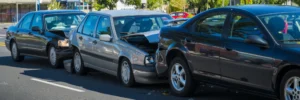Understanding Liability in Multi-Vehicle Accidents~3 min read
Multi-vehicle accidents can be incredibly complex and stressful. When you’re involved in such a situation, figuring out who is at fault can feel overwhelming. Liability in these accidents isn’t always clear-cut, and multiple factors can influence the outcome. Here’s a breakdown to help you understand how liability is determined in multi-vehicle accidents.
What is a Multi-Vehicle Accident?

A multi-vehicle accident, often referred to as a pile-up, involves three or more vehicles. These accidents typically occur on highways or busy roads where high speeds and dense traffic can lead to chain reactions. The causes can range from distracted driving and speeding to adverse weather conditions and road hazards.
Determining Liability
In multi-vehicle accidents, liability is typically based on negligence. Here’s how it usually works:
- Chain Reaction: In a typical chain reaction crash, the driver who causes the initial collision is usually found at fault. For instance, if a car rear-ends another car, pushing it into a third vehicle, the driver who caused the first impact is often liable.
- Comparative Negligence: Texas follows a modified comparative negligence rule. This means that if you are found to be more than 50% at fault for the accident, you cannot recover damages. However, if you are 50% or less at fault, you can recover damages reduced by your percentage of fault.
- Multiple At-Fault Parties: In some cases, more than one driver may be at fault. For example, if several drivers were speeding or driving recklessly, they might share liability. In these scenarios, the court will apportion the fault among the drivers based on their level of negligence.
- Evidence and Investigation: To determine liability, insurance companies and legal experts will examine various pieces of evidence, including police reports, witness statements, traffic camera footage, and accident reconstruction reports. The more evidence you can provide, the clearer the picture of what happened.
Protecting Yourself After an Accident
If you find yourself in a multi-vehicle accident, there are several steps you should take to protect your rights:
- Seek Medical Attention: Your health is the top priority. Get checked by a medical professional, even if you don’t feel injured immediately.
- Document the Scene: Take photos of the accident scene, your vehicle, and any visible injuries. These can serve as crucial evidence later.
- Get Witness Information: If there are witnesses, get their contact information and statements. They can provide an unbiased account of what happened.
- Notify Your Insurance Company: Report the accident to your insurance company as soon as possible. Provide them with all the information you have gathered.
- Consult a Lawyer: Multi-vehicle accidents can be legally intricate. Consulting an experienced attorney can help ensure your rights are protected and you receive the representation and compensation you deserve.
Conclusion
Understanding the complexities of liability in multi-vehicle accidents is essential for protecting your rights and securing fair compensation. By being informed and taking the right steps after an accident, you can better manage the challenges that arise and ensure your interests are safeguarded.
Contact Springer & Lyle
If you’ve been involved in a multi-vehicle accident, the experienced team at Springer & Lyle is here to help. Our dedicated personal injury lawyers understand the complexities of these cases and will work hard to ensure you receive the compensation you deserve. Don’t let the stress of an accident overwhelm you. Contact us to today at 940.370.4033 to schedule a free consultation. Springer & Lyle is located at 1807 Westminster, Denton, TX 76205.

Frank Lyle
Frank Lyle is a veteran personal injury attorney and mediator with decades of experience. He is AV Preeminent rated by Martindale-Hubbell and has been selected as a Texas Super Lawyer multiple times. A past president of the Denton County Trial Lawyers Association, Mr. Lyle has represented hundreds of individuals in personal injury cases and insurance disputes. He is also the author of numerous legal articles and presentations.





